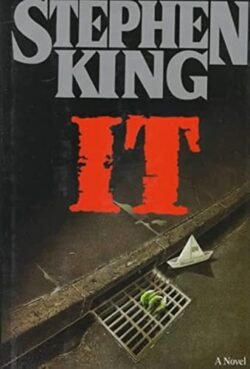“It” by Stephen King, published in 1986, is a landmark novel in the horror genre that explores the themes of childhood trauma, friendship, and the pervasive nature of fear. Set in the fictional town of Derry, Maine, the story alternates between two timelines: the late 1950s, when a group of seven children known as “The Losers’ Club” first encounter a malevolent entity that preys on the town’s children, and the mid-1980s, when the friends return as adults to confront “It” once again after a series of child disappearances resume. “It” primarily manifests as Pennywise the Dancing Clown, but it can take the form of its victim’s deepest fears. King weaves a complex narrative that delves into the lives of each member of The Losers’ Club, their individual and collective traumas, and their courageous battle against the embodiment of evil.
Character Analysis
- Bill Denbrough: The group's unofficial leader, motivated by the death of his younger brother, Georgie, at the hands of It. Bill's determination and belief play crucial roles in both timelines.
- Beverly Marsh: The only girl in the group, Beverly faces abuse at home and sexism in society but stands as a figure of strength and resilience among the Losers.
- Ben Hanscom: A new kid in town, Ben battles with issues of self-esteem due to his weight but is a loyal and resourceful member of the group, with a hidden talent for architecture.
- Richie Tozier: Known for his sense of humor and impressions, Richie often provides comic relief, though his fearlessness and loyalty are undeniable.
- Eddie Kaspbrak: Plagued by health issues and an overprotective mother, Eddie's growth is significant, learning to confront his fears and assert himself.
- Stan Uris: The most skeptical member of the group, Stan's logical and orderly mind struggles with the illogical nature of It.
- Mike Hanlon: The last to join the group, Mike is the historian of Derry, providing crucial background information on the town's dark history with It.
Themes and Analysis
- The Power of Memory and Trauma: "It" explores how childhood trauma can shape and haunt one's adult life, and how the act of remembering can be both painful and healing.
- The Essence of Evil: The novel personifies evil through It, examining how fear can consume and control individuals and communities.
- Friendship and Loyalty: At its core, "It" is a testament to the strength found in friendship and unity, showcasing how shared love and determination can overcome the most terrifying adversities.
Stephen King’s “It” is not only a masterpiece of horror but also a profound exploration of the complexities of childhood and the enduring impact of trauma. Through the terrifying experiences of The Losers’ Club, King addresses universal fears and the power of human connection to overcome darkness. The novel’s intricate narrative, rich character development, and thematic depth have cemented its place as a classic in literature. “It” continues to terrify and captivate readers, proving the enduring appeal of King’s storytelling prowess and his ability to delve into the human psyche.
If the summary caught your interest,
Consider reading the full book on AbeBooks.
Explore this book on AbeBooks
